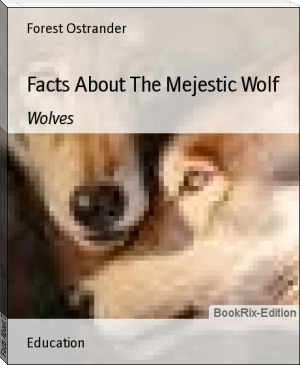Facts About The Mejestic Wolf by Forest Ostrander (autobiographies to read txt) 📖

- Author: Forest Ostrander
Book online «Facts About The Mejestic Wolf by Forest Ostrander (autobiographies to read txt) 📖». Author Forest Ostrander
(50) The "beta" wolf is the second ranking individual within the dominance hierarchy
(51) The "omega" wolf is the lowest ranking individual within the dominance hierarchy
(52) In the winter, the wolf's tail helps keep the face warm
(53) Wolves breed only once a year; most dogs breed twice
(54) In addition to the wolf (Canis lupus ), the genus Canis also contains the domestic dog, the coyote, the golden jackal, the black backed jackal, the side-striped jackal and the dingo
(55) Three (3) geographic races of the red wolf have been recognized; the Florida Red Wolf, The Mississippi Red Wolf and the Texas Red Wolf
(56) Wolves are often confused with Indian dogs, huskies, malemutes and German Shepherd Dogs
(57) Arctic tundra, taiga, plains or steppes, savannahs, hardwood, softwood and mixed forest were all originally inhabited by the wolf
(58) Adult male wolves average ninety-five to one hundred pounds and females about fifteen pounds less
(59) Wolves howl to greet one another, to indicate their location, to define their territorial boundaries, and to call the pack together
(60) Wolves can trot at five to ten miles per hour almost indefinitely
(61) A wolf may spend as much as a third of its time on the move
(62) The wolf is generally a docile animal with a strong aversion to fighting
(63) Submissive behavior plays a big role in maintaining peace within the pack
(64) A wolf's front feet are larger than their back feet
(65) Packs hunt in territories of up to 600 square miles
(66) A pack's home range will sometimes overlap the territory of another pack
(67) In addition to howling, wolves bark, yap, whine, and growl
(68) Litters of up to 14 pups are born in April through June
(69) Pups emerge from the den at about one month of age
(70) All members of a wolf pack take part in caring for the young
(71) When pack members return from the hunt and they are nipped on the snout by the pups, the hunters regurgitate undigested meat for them
(72) Wolves are considered to be competitors with people for game animals such as moose and caribou
(73) Although wolves are feared throughout much of the world, documented attacks on people are extremely rare
(74) Attempts to keep wolves as pets are not usually successful
(75) Wolves use direct scenting, chance encounter, and tracking to locate prey
(76) In scenting an animal, wolves must usually be downwind of the prey
(77) Wolves are active at all times of the day in winter
(78) Where waterways are plentiful, wolves often travel on the windswept and hardpacked ice in winter
(79) Wolves actually have a low hunting success rate
(80) To catch enough food, wolves must hunt often and test many animals before finding one that they can catch and kill
(81) Most packs contain less than eight members
(82) Wolves bear an average of six young per litter(82) Wolves become sexually mature at approximately twenty-two months
(83) Strong bonds are needed to hold a pack together; if there were no bonds, each wolf would go its separate way
(84) Most packs include a pair of breeding adults, pups, and extra adults that may also breed
(85) Ambushing is used by both single wolves and by packs
(86) Wolves at one time had an extensive range, occurring throughout North America, Europe, Asia, and Japan
(87) The only substantial population of wolves left at present in the contiguous 48 states inhabits northern Minnesota
(88) The range of the red wolf once extended from eastern Texas to Georgia and Florida and northward through Oklahoma, Arkansas, and Illinois
(89) The basic unit of wolf society is the pack
(90) The wolf's front teeth are sharp and pointed and adapted to puncturing, slashing, and clinging
(91) The wolf's pointed premolars and molars are useful for tearing and shearing once the prey has been killed
(92) The wolf's massive rear molars aid in cracking and crushing bones
(93) The wolf does little chewing
(94) A wolf can consume almost twenty pounds of prey at a feeding
(95) Wolves can maintain a chase for at least twenty minutes
(96) The wolf feeds almost exclusively on flesh, bones, and other animal matter
(97) Lone wolves have no social territory and rarely scent-mark or howl
(98) The range size for a given pack of wolves depends on many environmental factors, particularly prey density
(99) It is common for wolves to be moving eight to ten hours in a day
(100) A pack may cover distances from 30-125 miles in a day
(101) Wolves possess upwards of two hundred million olfactory cells
(102) A wolf's tail hangs while the tail of the dog tends to be held high and is often curly
Body :
The average adult wolf is 127 to 164 cm long from nose to tail.An adults tail is 47 mm long. A pup's tail is about 27 mm long.The front paws are smaller than the back paws. Wolf paws are 2 times bigger than a coyote paws.
Wolf Pups :
Mating season is from January to April. Pups are born about 63 days after breeding. The average litter is 6 pups. The mother stays close to the young for about 2 months. She eats some food then throws it up for her pups to eat. The pups start getting teeth in the third week. A wolf lives approximately 10 years.
Wolf Packs :
There are 4 to 36 wolves in a pack. Two to six of them stay at the den. They have a territory that ranges from 130 to 13,000 km. They will defend it. They eat anything from a mouse to a moose, depending on what is available.
Hunting :
Wolves either hunt in packs or alone. They follow their prey. They hunt elk, deer, sick animals and weak animals.
Communication :
You can tell wolves are friendly ,when they roll over and show their bellies. When they want to play, they put their paws down and wag their tail. When they want to fight, they show their fangs and start growling. When they want to stop they put their ears back and lay down. Imprint
Publication Date: 08-21-2010
All Rights Reserved
 The desire to acquire knowledge about the surrounding world and human society is quite natural and understandable for a person. Life is so developed that an uneducated person will never occupy a high position in any field. Humanity in its mass, and each person individually, develops objectively, regardless of certain life circumstances and obstacles, but with different intensity. The speed of development depends on the quality of training.
The desire to acquire knowledge about the surrounding world and human society is quite natural and understandable for a person. Life is so developed that an uneducated person will never occupy a high position in any field. Humanity in its mass, and each person individually, develops objectively, regardless of certain life circumstances and obstacles, but with different intensity. The speed of development depends on the quality of training.




Comments (0)